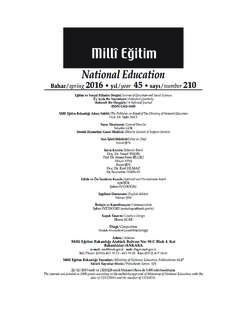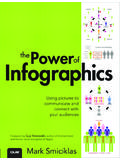Transcription of Jargon - New York News Publishers Association
1 This glossary of newspaper terms was developed to increase the understanding of the terms and acronyms that may be unique to the newspaper industry. It was created by the New York Newspaper Publishers Association , Newspaper In Education program with heavy contributions from The Democrat & Chronicle s, Newspaper Jargon booklet whose contents were written by Val Busacco, Advertising Administrative Assistant and by contributions from Craig Lancto of CCI Press..the specialized vocabulary of those in the same work, way of life, etc. A ABC: (Audit Bureau of Circulations). a non-profit industry auditing firm organized to verify circulation of member newspapers and magazines. ABOVE THE FOLD the most important stories of the day appear on the top half of the cover above the fold where they can show in coin boxes or on stacks.
2 ACCOUNTS PAYABLE: Department responsible for amounts owed to suppliers. ACCOUNTS RECEIVABLE: Department responsible for amounts owed by customers of the newspaper. ACCRUAL: 1. Expense accrual - an amount recorded as an expense representing a cost incurred for goods delivered or services rendered. 2. Revenue accrual - an amount recorded as representing revenue earned for goods delivered or services rendered. 3. Reverse accrual - an amount recorded that reverses a prior accrual. ADJUSTMENT: Compensation to an advertiser when the newspaper makes an error in an ad. (see MAKE-GOOD) AD SERVICES: The department responsible for layout of the newspaper. ADVANCE RUN: Sections of the newspaper that are printed before the publication date, and then inserted into the paper. AGATE: A type size, approximately 5-1/2 points or 14 lines per inch, used mainly in sports scores, legal notices, stocks, credit lines and classified line ads.
3 ART ONLY: A feature or news photo that does not have an accompanying story. ARTWORK: Materials other than text, such as photos, illustrations and diagrams. AUDIENCE: The people or households who are exposed to the newspaper. B BACK COPIES: Copies of the newspaper with prior publication dates. BAD BREAK: A word that is incorrectly hyphenated, or broken, at the end of a line of text. BALLOON: A cartoon device, used in comic strips and occasionally in other ways, that show the words of a person coming directly from his mouth or thoughts from their mind. BANNER: The main headline that runs across the top of the front page. BEAT: Area assigned to a reporter for regular coverage: for example, police or city hall. Also, a term sometimes used for an exclusive story. BENDAY: A piece of film with an overall pattern of halftone dots, used to create a shaded area.
4 Named after Benjamin Day, an American printer. BEST FOOD DAY: The day newspapers focus on food-related editorial content. BIT: The smallest unit of information that a computer can hold. BULLET POINT: A heavy dot, or bullet, followed by brief copy. BLACK PLATE: The plate used with cyan, magenta, and yellow plates to create a process color image. BLANKET: Rubber-surfaced fabric that encases the cylinder of an offset press to transfer the image from the plate to the paper. BLEED: To print past the finished image area into the trim area. BLEED-THROUGH: A printed image on the reverse side of the page that can he seen through the paper. BLOWUP: An enlargement of an advertisement or message. BLUELINE: 1. Type of proof. 2. To mark with non-reproducing blue pencil to indicate corrections or changes. BODY: Refers to the physical characteristic of inks, consistency.
5 BOX NUMBER: A number assigned to a classified advertisement at the advertiser s request to conceal the identity of the advertiser. BOX SCORE: Statistics of a baseball game, football game, or other sporting event, giving details and scores inning by inning, quarter by quarter. BREAK: 1. The point at which a story turns from one column to another or "jumps" to another page. 2. The time when a story becomes available for publication. News is said to break when it happens BROADSHEET: A full-sized newspaper. Dimensions for a broadsheet page vary from about 25" x " to 27" x 23". BUDGET: List of stories for the next day s paper. BUDGET MEETING: A conference to decide which stories will appear in the next day s paper, and where. BULLDOG: Earliest/first edition of a newspaper. BULL S EYE: A type of registration mark. BULKED OUT: Inserts delivered separately to carriers to hand insert into the paper instead of machine inserted at the production facility.
6 BUMP: To move a story in time, or to another location in the newspaper. BUNDLES: Packages of newspapers delivered by truck to various drop points for distribution into the community. BUNDLE TOP: List of starts, stops, complaints and messages for carriers. BURIED LEAD: The point of the story that is buried in the story instead of being in the first paragraph. BUREAU: A branch news and/or advertising office. BYLINE: A line at the beginning of an article that gives the name of the writer(s). C CALIBRATE: To adjust imaging equipment to ensure standards are met. CAMERA-READY: Material ready for the Plate Camera Department. Composition not needed. CAPTION: The title or brief description of a picture; a cutline. CARRIER: Independent contractor who delivers newspapers in a given district/route. CHOKE: 1. Process by which an image is slightly reduced to provide an outline between that image and an adjacent image.
7 2. A jamming of the press equipment with newsprint, usually refers to a fold jam. CHURN: 1. Term which describes the selling of new subscriptions and losing of others. 2. Term which describes the selling of new advertising and losing of others. CIRCULATION: The number of newspaper copies sold or distributed. Circulation figures of established consumer media are audited by the Audit Bureau of Circulations (ABC). Circulation figures do not determine the number or quality of a publication s readers and should not be confused with READERSHIP. CITY EDITOR: The editor in charge of the collection, writing and editing of local news. CLASSIFIED ADVERTISING: advertising arranged according to the product or service advertised, and usually restricted in size and format. The ads are "classified" into various categories such as help wanted, autos for sale, apartments for rent, etc.
8 CLIP: A tear sheet or photocopy of a published article. Editors usually require them as proof of previous publication or to evaluate a writer s suitability. CLIPART GRAPHICS: Electronically filed directory of logos and various pieces of art frequently used in ads. CMYK: The four process colors used for printing full color pictures: Cyan, Magenta, Yellow, and blacK. (See Color Separation) COLOR CORRECTION: Adjustments made during the color separation process to compensate for known deficiencies. COLOR GUIDES: Printed tonal scales of each of the process colors and as many combinations of colors as possible, to be used for comparison with a sample. Also used with layout to indicate color placement. Also called color charts. COLOR KEY: A proof made from film; used to compare color quality and consistency with the original.
9 COLOR SEPARATION: Four negatives for a four color photo that carry the halftone dots for the basic primary colors cyan, magenta yellow, and black. COLUMN: Vertical dimensions of a newspaper page that change in width depending upon the product. Editorial and Retail Advertising are composed of six columns per broadsheet page: Classified Advertising is composed of 10 columns. COLUMN INCH: One vertical inch of a column or leg. The length of stories is sometimes calculated by column inches, sometimes by number of words. COLUMNIST: A writer using the same space daily, such as Ann Landers, in contrast to a reporter. CO-OP ADVERTISING: Ads run by a local advertiser in conjunction with a national advertiser. National usually provides the copy and/or artwork, and the local advertiser s name/address appears in the ad. Ad cost is shared.
10 COPY: 1. Material submitted with the layout for inclusion in an ad or news reproduction. 2. A single newspaper. COPY EDITOR: A newspaper worker who corrects or edits copy written by a reporter and writes headlines. COPYRIGHT: Ownership of intellectual property such as a story or photograph. It protects the owner s right to decide where, when, and by whom the work is published. CPM: 1. (Cost per thousand), A figure used in comparing or evaluating the cost efficiency of advertising schedules; determined by dividing the cost of the ad by the number of homes. Circulation costs are divided by the number of net paid newspapers to arrive at the CPM. Advertising rates are evaluated by determining ad cost to customers by dividing that cost by net paid circulation copies. 2. Complaints per thousand. A way of measuring the number of complaints per thousand papers delivered.



